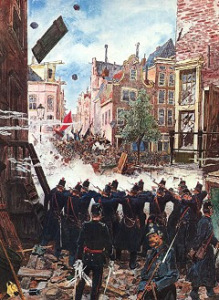I Predict A Riot – Part Fifteen
The eel pulling riot, 1886
Throughout history people have found some strange ways to keep themselves amused. I’m not sure I quite see the attractions of palingtrekken or eel pulling but it was amazingly popular amongst the poorer sorts in 19th century Amsterdam.
It was a pretty simple sport. A rope would be stretched across a canal and a live eel would be suspended from the middle of it, hanging down. Contestants would then stand in open boats navigating the canal and would try to snatch the poor creature free. Great acclaim was reserved for anyone determined enough to release the eel. But, of course, an eel is metaphorically slippery and in the predicament it found itself would be scared out of its wits. This meant it was difficult to grasp and many a contestant would find themselves in the water of the canal, to the amusement of the crowds of bystanders on the bank. What sport!
Even by the standards that endured in the late 19th century palingtrekken was recognised, by the authorities at least, as a gratuitously cruel sport and attempts were made to clamp down on the fun. Organisers announced in July 1886 that they were going to stage a contest at the Lindengracht. This was duly banned by the authorities.
Notwithstanding this minor inconvenience, the organisers pressed on and on Sunday 25th July a large crowd gathered on the banks of the Linden canal to watch the proceedings. The police moved in and their attempts to put a halt to contest were resisted by the locals. A full-blown riot ensued and order was only eventually restored that evening.
But that wasn’t the end of the affair. The following day the residents of the poor and working class quarter of Jordaan joined and matters took a more serious and disturbing turn. Paving stones were ripped up to serve as missiles and barricades were erected on the streets. The police moved in and were pelted with heavy objects thrown down from the roofs of the nearby buildings. A crowd armed with sticks and rods lay siege to the local cop shop. So serious was the violence that the army had to be brought in and permission was granted to fire live ammunition – to disastrous effect.
The barricades were torn down, one by one, as the army swept through the district, firing randomly until order was finally restored by nightfall. 26 people had lost their lives and over one hundred people had been injured.
In the immediate post-riot enquiry concerns were voiced that this riot had more sinister overtones and was part of a socialist plot to overturn Dutch society. Many of the rioters who had been arrested were interrogated but the public prosecutor concluded that the riot had been spontaneous, rather than planned. It was, however, a popular expression of the discontent of the poorer classes over their lot and heavy-handed authoritarian attempts to deny them what pleasure they could find.
As for the eel that was hanging from the canal bridge whilst all hell broke out, it was taken down and reputedly sold, in 1913, for the princely sum of 1.75 guilders, after which it disappeared, never to be seen again. I would assume it was too old to be eaten.
Filed under: Culture, History Tagged: death toll in eel pulling riot, eel pulling, Lindengracht, palingtrekken, the eel pulling riot of Amsterdam 1886













